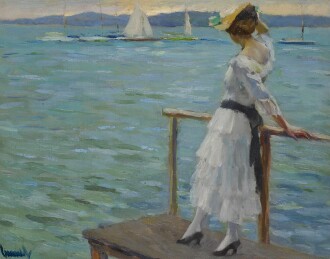S otheby’s is pleased to present our Fall 2021 installment of the online auction series, Two Centuries: American Art. The auction will present paintings, sculptures and works on paper representative of the diverse subject matter and artistic styles that defined American Art through the 19th and 20th centuries. This auction will be led by a selection of abstract paintings from the Gouterman American Art Collection. The sale will feature an assortment of 19th Century paintings from the Brooklyn Museum, Sold to Support Museum Collections, as well as Hudson River School landscapes from the Collection of Orin Lehman. Works by Theodore Earl Butler, William Merritt Chase, William Harnett, Julian Alden Weir and Guy Wiggins are to be sold by an Important East Coast Collection.



The present work is one of five versions Sanford Robinson Gifford painted of the Arch of Nero near the Italian city of Tivoli. The largest and most significant of these works, The Arch of Nero, 1871, is in the collection of The Walters Art Museum in Baltimore, Maryland. On one ambitious trip abroad in 1868, Gifford traveled to Rome and then to Tivoli for a week of sketching with other American artists including his good friend Jervis McEntee. Gifford’s practice in completing large scale exhibition pieces often involved his incremental development of the subject in a series of oil sketches and paintings based upon pencil drawings he completed onsite.
According to the leading Sanford Robinson Gifford scholar, Dr. Ila Weiss, “[The present work] is closer to the artist’s observation and retains the immediacy of his touch, consistent with Gifford’s size related practice. One can almost feel the stony road, the textures of darker and lighter reddish Roman bricks and gray medieval stones, and the dense haze obscuring the distance. The artist’s heightened experience of the site, informed by nostalgic reminiscences of his late brothers and the inspiration of the influential older artist, is palpable . . . [The present work], with its more tactile, gestural brushwork, conveys the actuality of Gifford’s experience of the place and its personal impact."















































